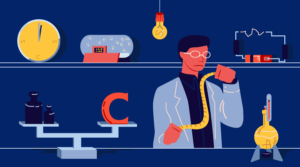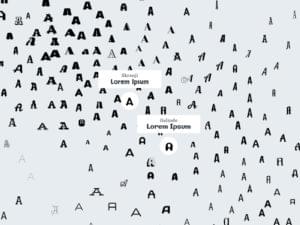 Our third tutorial for CSS Theme Week went live today — a new article titled Warning: This Secret CSS Technique Could Surprise You!.
Read previous articles from CSS Theme Week:
Today’s article was written by our own Alex Walker, a man with an unhealthy obsession for spotting an anomaly and exploring it in great detail (I sit next to Alex, so I know how much time he put into this tutorial). This article is the result of that exploring.
A while back Alex published a blog post about the fun that could be had when you explored overlapping CSS background images. At that stage, the effect he had produced was interesting and useful, though admittedly in limited cases (we applied it to the ad on the front page of sitepoint.com to promote our Art & Science of JavaScript book). While not immediately practical in every situation, it demonstrated one way of embedding a hidden feature into your page — an “easter egg” for your users.
Those easter eggs aren’t going to make or break your design — in fact, chances are that most of them won’t notice it — but they’re a nice touch and an attention to detail that might make a few users raise an eyebrow. The very same effect was even used by the folks at Clearleft to create the parallax effect used on the landing page for their Silverback usability testing software.
The next logical step in Alex’s thinking was to push this technique to its limit. The result is an animation that runs only when the user resizes the window. Oh, and it doesn’t use any JavaScript. Check out the example.
Our third tutorial for CSS Theme Week went live today — a new article titled Warning: This Secret CSS Technique Could Surprise You!.
Read previous articles from CSS Theme Week:
Today’s article was written by our own Alex Walker, a man with an unhealthy obsession for spotting an anomaly and exploring it in great detail (I sit next to Alex, so I know how much time he put into this tutorial). This article is the result of that exploring.
A while back Alex published a blog post about the fun that could be had when you explored overlapping CSS background images. At that stage, the effect he had produced was interesting and useful, though admittedly in limited cases (we applied it to the ad on the front page of sitepoint.com to promote our Art & Science of JavaScript book). While not immediately practical in every situation, it demonstrated one way of embedding a hidden feature into your page — an “easter egg” for your users.
Those easter eggs aren’t going to make or break your design — in fact, chances are that most of them won’t notice it — but they’re a nice touch and an attention to detail that might make a few users raise an eyebrow. The very same effect was even used by the folks at Clearleft to create the parallax effect used on the landing page for their Silverback usability testing software.
The next logical step in Alex’s thinking was to push this technique to its limit. The result is an animation that runs only when the user resizes the window. Oh, and it doesn’t use any JavaScript. Check out the example.
 The obvious question, of course, is why would you go to all the trouble? Creating the graphics for this effect is far from trivial.
The answer is simple: because you can. There are techniques that web designers the world over use every day — image replacement, sliding doors, faux columns… all of these techniques originated because someone thought “What if…?”
Perhaps you’ll find a way to use this technique to do something interesting, something cool, or something useful. If you do, be sure to let us know in the comments of this post.
Oh, and don’t forget to thank Alex for daring to think he might be able to make an animation implemented purely in CSS, triggered by the user resizing the window. I know if he’d told me his plans prior to writing this tutorial, I’d have told him that he was crazy.
Actually, I still think he might be. You be the judge …
Read the article on sitepoint.com.
The obvious question, of course, is why would you go to all the trouble? Creating the graphics for this effect is far from trivial.
The answer is simple: because you can. There are techniques that web designers the world over use every day — image replacement, sliding doors, faux columns… all of these techniques originated because someone thought “What if…?”
Perhaps you’ll find a way to use this technique to do something interesting, something cool, or something useful. If you do, be sure to let us know in the comments of this post.
Oh, and don’t forget to thank Alex for daring to think he might be able to make an animation implemented purely in CSS, triggered by the user resizing the window. I know if he’d told me his plans prior to writing this tutorial, I’d have told him that he was crazy.
Actually, I still think he might be. You be the judge …
Read the article on sitepoint.com.
Frequently Asked Questions (FAQs) about CSS Animation Easter Eggs
What are CSS Animation Easter Eggs and how do they enhance a website’s user experience?
CSS Animation Easter Eggs are hidden interactive elements or features that can be triggered on a website. They are often used to surprise and delight users, adding an element of fun and engagement to the user experience. These Easter Eggs can range from simple color changes to complex animations and can be triggered by various user actions such as clicking, hovering, or scrolling. They can make a website more memorable and engaging, encouraging users to spend more time exploring and interacting with the site.
How can I create a CSS Animation Easter Egg?
Creating a CSS Animation Easter Egg involves using CSS properties to define the animation and its behavior. This typically involves specifying keyframes for the animation, which define the start and end states of the animation, and any intermediate steps. You can also control the duration, timing function, and iteration count of the animation using CSS properties. To trigger the animation, you can use JavaScript to add or remove a CSS class when a certain event occurs.
Can I use CSS Animation Easter Eggs on any website?
Yes, CSS Animation Easter Eggs can be used on any website. However, they should be used sparingly and in a way that enhances the user experience rather than distracting from it. It’s also important to ensure that the Easter Eggs are accessible and don’t interfere with the usability of the site for users with disabilities.
What are some examples of CSS Animation Easter Eggs?
Examples of CSS Animation Easter Eggs could include a hidden menu that appears when a certain element is clicked, a character that moves across the screen when the user scrolls, or a color change that occurs when the user hovers over an element. The possibilities are limited only by your creativity and the capabilities of CSS and JavaScript.
How can I make my CSS Animation Easter Eggs accessible?
To make your CSS Animation Easter Eggs accessible, ensure that they can be triggered using both mouse and keyboard inputs, and that they don’t rely solely on color changes that may not be visible to color-blind users. You should also provide alternative text for any visual elements, and ensure that the Easter Eggs don’t interfere with screen readers or other assistive technologies.
Can CSS Animation Easter Eggs affect website performance?
While CSS animations are generally more performance-efficient than JavaScript animations, they can still affect website performance if used excessively or inefficiently. It’s important to test your website’s performance with the animations enabled, and to optimize your animations to minimize their impact on performance.
How can I test my CSS Animation Easter Eggs?
You can test your CSS Animation Easter Eggs by triggering them in various ways and on different devices and browsers to ensure they work as expected. You can also use performance profiling tools to measure the impact of the animations on your website’s performance.
Can I use CSS Animation Easter Eggs in responsive design?
Yes, CSS Animation Easter Eggs can be used in responsive design. However, you may need to adjust the animations or the way they are triggered to ensure they work well on different screen sizes and devices.
How can I learn more about creating CSS Animation Easter Eggs?
There are many online resources and tutorials available that can help you learn more about creating CSS Animation Easter Eggs. You can also experiment with creating your own animations and Easter Eggs, and learn from the process.
Are there any best practices for using CSS Animation Easter Eggs?
Best practices for using CSS Animation Easter Eggs include using them sparingly and in a way that enhances the user experience, making them accessible, testing them thoroughly, and optimizing them for performance. It’s also important to keep up to date with the latest CSS and JavaScript techniques and standards to ensure your animations are as effective and efficient as possible.
 Matthew Magain
Matthew MagainMatthew Magain is a UX designer with over 15 years of experience creating exceptional digital experiences for companies such as IBM, Australia Post, and sitepoint.com. He is currently the Chief Doodler at Sketch Group, Co-founder of UX Mastery, and recently co-authored Everyday UX, an inspiring collection of interviews with some of the best UX Designers in the world. Matthew is also the creator of Charlie Weatherburn and the Flying Machine.




